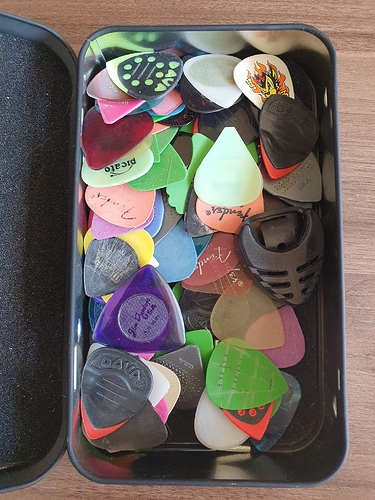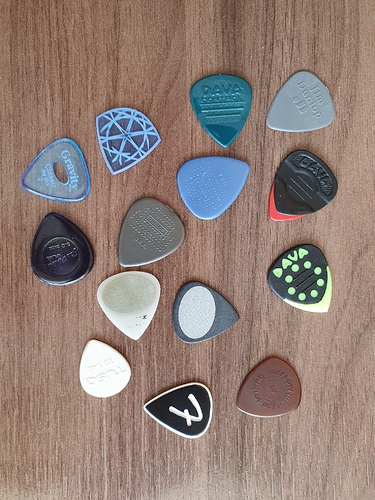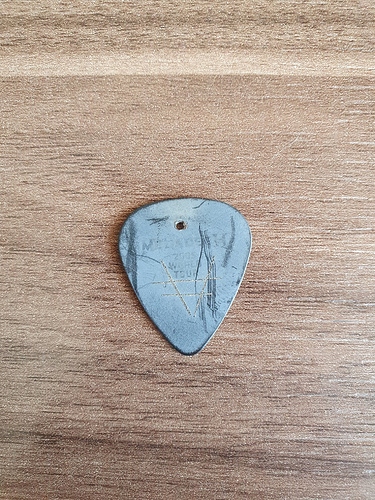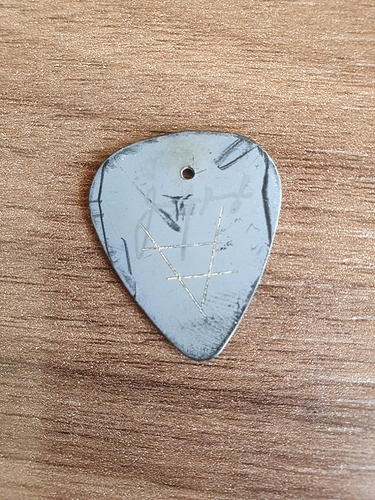Is the CTC terminology for this called ‘pick-point’?? I remember thi coming up at some point, but didn’t follow up on it…
@PickingApprentice Honestly I’m not sure, I don’t see it talked about anywhere near as much as picking motions and escape mechanics.
I think that if you look at my thumb the pick might look somewhat as you describe, but basically I adjust my grip so that the pick always points straight down at the strings. In my world view the pick “needs” to hit the string at 90 degrees, and my thumb will hold it accordingly. By pinching the pick along the middle axis everything is quite stable and it won’t rotate even with a very lax grip, although as I mentioned, my picks do have tiny raised dots on them to hinder movement.
Hey thanks for that explanation and drawing! I’ll do some experimenting tomorrow and see if I have understood you correctly. I was actually thinking about trying out some new picks also, not just for grip, but for some tonal options also. I think I’ll add the Dunlop Flow 2mm to the list as I’ve seen them mentioned a few times now!
Thanks again for your explanation and hopefully I’ve understood it correctly!
Yes that is what’s referred to as pick point in the primer. Some forms can cause the pick to either be positive (towards the headstock) or negative (towards the bridge)
So, if you extend your wrist, you may need to dial in some negative pick point, extremely slightly, or it may happen automatically as you play.
But if you play with a flexed wrist, you might need to dial in positive pick point, or again it may just happen by itself.
In some of the videos, you can see the positive pick point that some Gypsy jazz players have and if I have understood things correctly, it would be mostly down to the flexion of the wrist.
Hope that makes sense!
I have had problems with the pick rotating in my hand as long as I remember holding a pick.
My observations and thoughts:
- Troy is right that when you are alternating pick strokes the forces are balancing themselves so the pick will find an equilibrium position. However, if you are only downpicking using edge picking (i.e. hitting the string with only one edge of the pick) there is no balancing force and it will tend to move in the opposite direction.
- Accepting this fact, you need to deal somehow with it. No arguing with the laws of physics

- One obvious way is to grip harder. However, you have limit so how hard you can grip and still avoid tensing you whole hand
- To lessen the needed gripping you can use picks that have a surface with higher friction. I have tried each and evey one I have come accross. So far I’m most satisfied with Dunlop MaxGrip Nylon and Dunlop Flow.
Also, someone said that the big guys don’t complain from pick rotation. Well, I was lucky enough to get a Megadeth pick from a concert and guess what - it has deep knife scratches on both sides. So, I guess they don’t complain publicly but nevertheless have to deal with it. Which is why in the past I started scratching my picks with a knife. It works just fine, so if you don’t want to change brands and materials - there you have it. Keep in mind that the scratches smoothen over time and you need to renew them.
I have also tried the Monster Grips but find that the rubber gets rather slippery when you fingers are sweaty. - Another way is to use a grip with bigger contact area with the fingers. I find that angled padding (I think this is what Troy called it) provides that.
- Finally, most riffs have natural breaks in them - longer notes and chords - that give you the opportunity to readjust the pick
I’ll add pictures (and anything I have forgotten to mention) later.
You are totally right. There are situations where the pick is not going to be say 90degrees to the string.
I find that when using a medium supinated arm setup, the pick tends to go a little positive. Not a crazy amount, but just enough so that the upstrokes feel similar to the downstrokes. Trying to force the pick to be 90degrees, it doesn’t feel smooth at all and I can’t go fast.
I also noticed, when using the angle pad grip, if I used too much of the pad, almost like a pad to pad grip but not quite, the pick would have to go very positive to feel smooth. I’m guessing due to the difference in where I’m holding the pick giving naturally less edge picking and also the medium supinated arm setup. I have since fixed my grip a little after watching the video in the forearm and wrist picking section. The angle pad grip is explained again and it clicked with me that I didn’t have the contact points quite right.
Anyways, yes, if you look for it, you can see great players adjusting grip, or at least it appears that’s what they are doing, between some phrases. I notice it with Frank Gambale. I can’t say for certain that’s what he is doing, but it appears he may be, extremely quickly, adjusting the grip.
Did you ever try the Ibanez sand grip picks? I tried them for a while but found the sand grip would wear off after a few days and then felt a little slippery.
Yep! And I have the same observation - the sandpaper wears off pretty quickly.
Had to dig out this topic and post this clip YouTube recommended me: James Hetfield’s picking technique exposed #shorts - YouTube
I wish I had that box of picks right now, I love all the different types.
Surprised no one mentioned this easy fix: Drill a hole in the pick.
I began doing this decades ago.
Works great.
I had forgotten I posted this thread!
I don’t really have this issue anymore. It was purely technique issues!
Awesome! Do you remember specifically what change(s) you made that solved the problem?
I’ve been getting help from @Tom_Gilroy and he has helped improve my setup, dynamics, pick attack. Eternally grateful for his help!
I was doing a few things that could have contributed to the pick roatation issue.
One was quite a steel approach angle. Meaning I’m not playing through the string, but sort of across it. It’s difficult to explain but doing this caused upstrokes to knock the pick tip towards the headstock and the result was a scratchy weak sound.
Now I’ve made quite few minor changes to grip and form so it’s hard to say specifically what helped fix that issue. It may have been a few contributing factors, none of which were the picks fault 
Gravity Picks make picks with various holes in them. However, I’m not sure how this will stop the pick from rotating!?
I just glued two small squares of extra fine sandpaper to my Dunlop Jazz III. So far it’s been working.
Seems to me, the hole’s edges increase the friction between the skin and pick (aka. the coefficient of static friction between two surfaces). FWIW, the coefficient of kinetic friction is typically lower for most materials, meaning it takes more force to get the two surfaces slipping than to keep them slipping. Based on players’ comments, I’d say the force that causes a guitar pick to slip is usually very short lived and for those posting in this thread, is more related to up strokes when the pick first strikes the string. That’s the engineering answer in layman’s terms. There’s a link in engineeringlibrary dot org on coefficient of friction for those with a more technical background interested in the math.
FWIW, adding more holes would add more friction. I might add, I saw a photo of one of Les Paul’s personal picks: he glued sandpaper to it, which is in Tina’s Pick collection at tinaspicks dot com. That increased the coefficient of static and kinetic friction for the innovative trailblazing Mr. Paul’s personal picks (as picks were also produced with his name on them).






